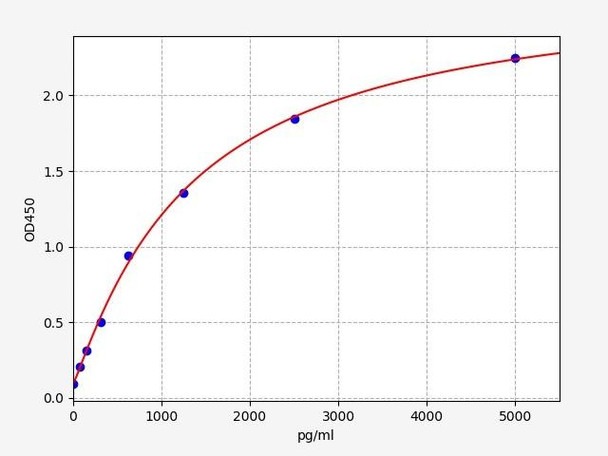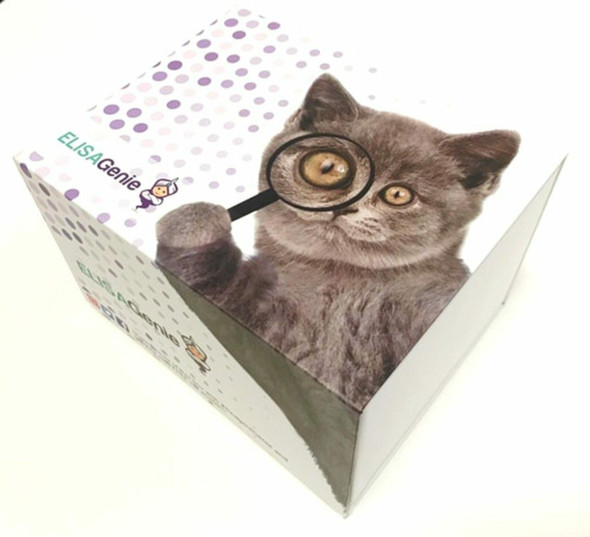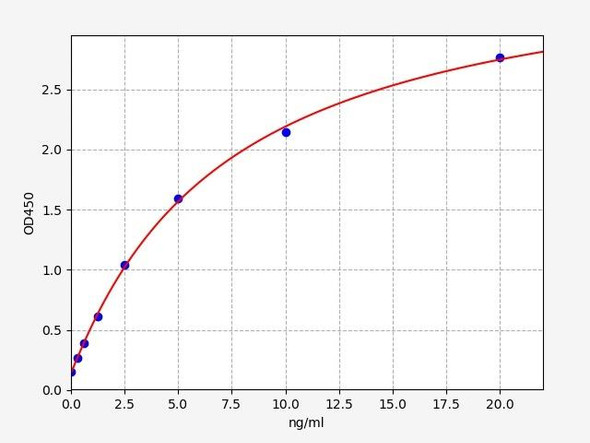Human SNAP23 (Synaptosomal-associated protein 23) ELISA Kit (HUFI06433)
- SKU:
- HUFI06433
- Product Type:
- ELISA Kit
- Size:
- 96 Assays
- Uniprot:
- O00161
- Sensitivity:
- 46.875pg/ml
- Range:
- 78.125-5000pg/ml
- ELISA Type:
- Sandwich
- Synonyms:
- Synaptosomal-associated protein 23, SNAP-23, Vesicle-membrane fusion protein SNAP-23, SNAP23
- Reactivity:
- Human
Description
Human SNAP23 (Synaptosomal-associated protein 23) ELISA Kit
The Human SNAP23 (Synaptosomal-Associated Protein 23) ELISA Kit is a reliable tool for the precise measurement of SNAP23 levels in human samples such as serum, plasma, and cell culture supernatants. With its high sensitivity and specificity, this kit ensures accurate and reproducible results, making it suitable for a variety of research applications.SNAP23 is a key protein involved in membrane fusion and vesicle trafficking, playing a crucial role in various cellular processes including exocytosis and intracellular transport.
Dysregulation of SNAP23 has been linked to conditions such as diabetes, obesity, and neurodegenerative diseases, making it a valuable biomarker for investigating these disorders and developing potential therapeutic interventions.Overall, the Human SNAP23 ELISA Kit is an essential tool for researchers studying the role of SNAP23 in cellular functions and disease pathogenesis, providing reliable data for advancing scientific understanding and clinical research.
| Product Name: | Human SNAP23 (Synaptosomal-associated protein 23) ELISA Kit |
| Product Code: | HUFI06433 |
| Size: | 96 Assays |
| Alias: | Synaptosomal-associated protein 23 ELISA Kit, SNAP-23 ELISA Kit, Vesicle-membrane fusion protein SNAP-23 ELISA Kit, SNAP23 ELISA Kit |
| Detection method: | Sandwich ELISA, Double Antibody |
| Application: | This immunoassay kit allows for the in vitro quantitative determination of Human SNAP23 (Synaptosomal-associated protein 23) concentrations in serum plasma and other biological fluids. |
| Sensitivity: | < 46.875pg/ml |
| Range: | 78.125-5000pg/ml |
| Storage: | 4°C for 6 months |
| Note: | For Research Use Only |
| Recovery: | Matrices listed below were spiked with certain level of Human SNAP23 (Synaptosomal-associated protein 23) and the recovery rates were calculated by comparing the measured value to the expected amount of Human SNAP23 (Synaptosomal-associated protein 23) in samples. | ||||||||||||||||
| |||||||||||||||||
| Linearity: | The linearity of the kit was assayed by testing samples spiked with appropriate concentration of Human SNAP23 (Synaptosomal-associated protein 23) and their serial dilutions. The results were demonstrated by the percentage of calculated concentration to the expected. | ||||||||||||||||
| |||||||||||||||||
| CV(%): | Intra-Assay: CV<8% Inter-Assay: CV<10% |
| Component | Quantity | Storage |
| ELISA Microplate (Dismountable) | 8×12 strips | 4°C for 6 months |
| Lyophilized Standard | 2 | 4°C/-20°C |
| Sample/Standard Dilution Buffer | 20ml | 4°C |
| Biotin-labeled Antibody(Concentrated) | 120ul | 4°C (Protect from light) |
| Antibody Dilution Buffer | 10ml | 4°C |
| HRP-Streptavidin Conjugate(SABC) | 120ul | 4°C (Protect from light) |
| SABC Dilution Buffer | 10ml | 4°C |
| TMB Substrate | 10ml | 4°C (Protect from light) |
| Stop Solution | 10ml | 4°C |
| Wash Buffer(25X) | 30ml | 4°C |
| Plate Sealer | 5 | - |
Other materials and equipment required:
- Microplate reader with 450 nm wavelength filter
- Multichannel Pipette, Pipette, microcentrifuge tubes and disposable pipette tips
- Incubator
- Deionized or distilled water
- Absorbent paper
- Buffer resevoir
| UniProt Protein Function: | SNAP23: a member of the SNAP-25 family of SNARE proteins. Structurally and functionally similar to SNAP25 and binds tightly to multiple syntaxins and synaptobrevins/VAMPs. It is an essential component of the high affinity receptor for the general membrane fusion machinery and is an important regulator of transport vesicle docking and fusion. Two alternatively spliced isoforms have been described. |
| UniProt Protein Details: | Protein type:Vesicle Chromosomal Location of Human Ortholog: 15q14 Cellular Component: nucleoplasm; SNARE complex; azurophil granule; specific granule; neuron projection; mast cell granule; focal adhesion; cytoplasm; plasma membrane; synapse Molecular Function:SNAP receptor activity; protein binding; syntaxin binding Biological Process: synaptic vesicle fusion to presynaptic membrane; protein transport; histamine secretion by mast cell; vesicle targeting; post-Golgi vesicle-mediated transport; synaptic vesicle priming |
| NCBI Summary: | Specificity of vesicular transport is regulated, in part, by the interaction of a vesicle-associated membrane protein termed synaptobrevin/VAMP with a target compartment membrane protein termed syntaxin. These proteins, together with SNAP25 (synaptosome-associated protein of 25 kDa), form a complex which serves as a binding site for the general membrane fusion machinery. Synaptobrevin/VAMP and syntaxin are believed to be involved in vesicular transport in most, if not all cells, while SNAP25 is present almost exclusively in the brain, suggesting that a ubiquitously expressed homolog of SNAP25 exists to facilitate transport vesicle/target membrane fusion in other tissues. The protein encoded by this gene is structurally and functionally similar to SNAP25 and binds tightly to multiple syntaxins and synaptobrevins/VAMPs. It is an essential component of the high affinity receptor for the general membrane fusion machinery and is an important regulator of transport vesicle docking and fusion. Two alternative transcript variants encoding different protein isoforms have been described for this gene. [provided by RefSeq, Jul 2008] |
| UniProt Code: | O00161 |
| NCBI GenInfo Identifier: | 6685971 |
| NCBI Gene ID: | 8773 |
| NCBI Accession: | O00161.1 |
| UniProt Secondary Accession: | O00161,O00162, Q13602, Q6IAE3, |
| UniProt Related Accession: | O00161 |
| Molecular Weight: | 17,789 Da |
| NCBI Full Name: | Synaptosomal-associated protein 23 |
| NCBI Synonym Full Names: | synaptosomal-associated protein, 23kDa |
| NCBI Official Symbol: | SNAP23 |
| NCBI Official Synonym Symbols: | SNAP-23; SNAP23A; SNAP23B; HsT17016 |
| NCBI Protein Information: | synaptosomal-associated protein 23; synaptosomal-associated protein, 23kD; vesicle-membrane fusion protein SNAP-23 |
| UniProt Protein Name: | Synaptosomal-associated protein 23 |
| UniProt Synonym Protein Names: | Vesicle-membrane fusion protein SNAP-23 |
| Protein Family: | Synaptosomal-associated protein |
| UniProt Gene Name: | SNAP23 |
| UniProt Entry Name: | SNP23_HUMAN |
*Note: Protocols are specific to each batch/lot. For the correct instructions please follow the protocol included in your kit.
Before adding to wells, equilibrate the SABC working solution and TMB substrate for at least 30 min at 37 °C. When diluting samples and reagents, they must be mixed completely and evenly. It is recommended to plot a standard curve for each test.
| Step | Protocol |
| 1. | Set standard, test sample and control (zero) wells on the pre-coated plate respectively, and then, record their positions. It is recommended to measure each standard and sample in duplicate. Wash plate 2 times before adding standard, sample and control (zero) wells! |
| 2. | Aliquot 0.1ml standard solutions into the standard wells. |
| 3. | Add 0.1 ml of Sample / Standard dilution buffer into the control (zero) well. |
| 4. | Add 0.1 ml of properly diluted sample ( Human serum, plasma, tissue homogenates and other biological fluids.) into test sample wells. |
| 5. | Seal the plate with a cover and incubate at 37 °C for 90 min. |
| 6. | Remove the cover and discard the plate content, clap the plate on the absorbent filter papers or other absorbent material. Do NOT let the wells completely dry at any time. Wash plate X2. |
| 7. | Add 0.1 ml of Biotin- detection antibody working solution into the above wells (standard, test sample & zero wells). Add the solution at the bottom of each well without touching the side wall. |
| 8. | Seal the plate with a cover and incubate at 37 °C for 60 min. |
| 9. | Remove the cover, and wash plate 3 times with Wash buffer. Let wash buffer rest in wells for 1 min between each wash. |
| 10. | Add 0.1 ml of SABC working solution into each well, cover the plate and incubate at 37 °C for 30 min. |
| 11. | Remove the cover and wash plate 5 times with Wash buffer, and each time let the wash buffer stay in the wells for 1-2 min. |
| 12. | Add 90 µL of TMB substrate into each well, cover the plate and incubate at 37 °C in dark within 10-20 min. (Note: This incubation time is for reference use only, the optimal time should be determined by end user.) And the shades of blue can be seen in the first 3-4 wells (with most concentrated standard solutions), the other wells show no obvious color. |
| 13. | Add 50 µL of Stop solution into each well and mix thoroughly. The color changes into yellow immediately. |
| 14. | Read the O.D. absorbance at 450 nm in a microplate reader immediately after adding the stop solution. |
When carrying out an ELISA assay it is important to prepare your samples in order to achieve the best possible results. Below we have a list of procedures for the preparation of samples for different sample types.
| Sample Type | Protocol |
| Serum | If using serum separator tubes, allow samples to clot for 30 minutes at room temperature. Centrifuge for 10 minutes at 1,000x g. Collect the serum fraction and assay promptly or aliquot and store the samples at -80°C. Avoid multiple freeze-thaw cycles. If serum separator tubes are not being used, allow samples to clot overnight at 2-8°C. Centrifuge for 10 minutes at 1,000x g. Remove serum and assay promptly or aliquot and store the samples at -80°C. Avoid multiple freeze-thaw cycles. |
| Plasma | Collect plasma using EDTA or heparin as an anticoagulant. Centrifuge samples at 4°C for 15 mins at 1000 × g within 30 mins of collection. Collect the plasma fraction and assay promptly or aliquot and store the samples at -80°C. Avoid multiple freeze-thaw cycles. Note: Over haemolysed samples are not suitable for use with this kit. |
| Urine & Cerebrospinal Fluid | Collect the urine (mid-stream) in a sterile container, centrifuge for 20 mins at 2000-3000 rpm. Remove supernatant and assay immediately. If any precipitation is detected, repeat the centrifugation step. A similar protocol can be used for cerebrospinal fluid. |
| Cell culture supernatant | Collect the cell culture media by pipette, followed by centrifugation at 4°C for 20 mins at 1500 rpm. Collect the clear supernatant and assay immediately. |
| Cell lysates | Solubilize cells in lysis buffer and allow to sit on ice for 30 minutes. Centrifuge tubes at 14,000 x g for 5 minutes to remove insoluble material. Aliquot the supernatant into a new tube and discard the remaining whole cell extract. Quantify total protein concentration using a total protein assay. Assay immediately or aliquot and store at ≤ -20 °C. |
| Tissue homogenates | The preparation of tissue homogenates will vary depending upon tissue type. Rinse tissue with 1X PBS to remove excess blood & homogenize in 20ml of 1X PBS (including protease inhibitors) and store overnight at ≤ -20°C. Two freeze-thaw cycles are required to break the cell membranes. To further disrupt the cell membranes you can sonicate the samples. Centrifuge homogenates for 5 mins at 5000xg. Remove the supernatant and assay immediately or aliquot and store at -20°C or -80°C. |
| Tissue lysates | Rinse tissue with PBS, cut into 1-2 mm pieces, and homogenize with a tissue homogenizer in PBS. Add an equal volume of RIPA buffer containing protease inhibitors and lyse tissues at room temperature for 30 minutes with gentle agitation. Centrifuge to remove debris. Quantify total protein concentration using a total protein assay. Assay immediately or aliquot and store at ≤ -20 °C. |
| Breast Milk | Collect milk samples and centrifuge at 10,000 x g for 60 min at 4°C. Aliquot the supernatant and assay. For long term use, store samples at -80°C. Minimize freeze/thaw cycles. |










